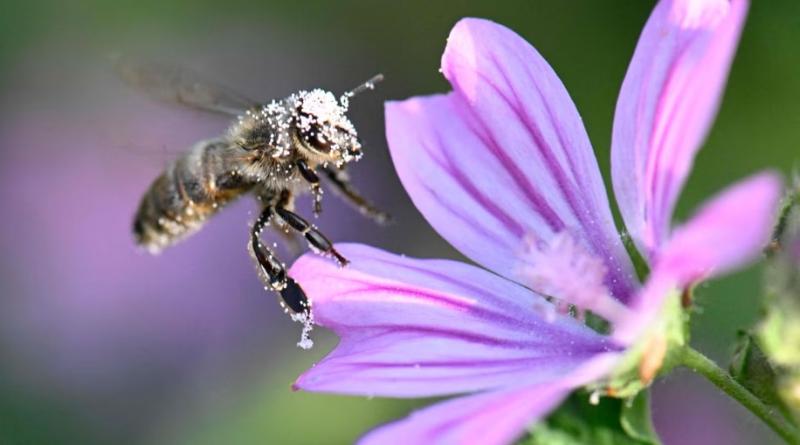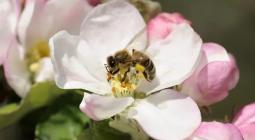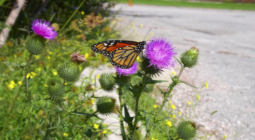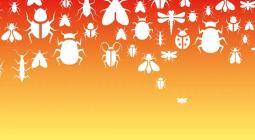Food, soil, water: how the extinction of insects would transform our planet

Cut an apple in half, and the white flesh reveals a cluster of black pips arranged in the shape of a star. It is a tiny constellation of seeds hidden in the fruit bowl. But it reveals an interlinked universe of pollination and nature’s abundance – a delicate system, and one that can easily be thrown off course.
When the apple blossoms are pollinated, seeds pump out hormones telling the plant to produce the right vitamins, minerals and rate of growth. They help formulate crunchiness, size and shape. Lose those pollinators, however, and this fragile system becomes unbalanced. If only three or four of the seeds get pollinated, our apple may grow lopsided. The nutritional value might decrease, as could the shelf-life of the fruit, turning it brown and wrinkled before its time.
The story of the apple is one being retold over and over across the world. A new report warns that two million species are at risk of extinction, twice as many as in previous estimates by the UN. This increase is down to better data on insect populations, which have been less understood than other groups.
Often, it is animals such as insects – the species we tend to care the least about – which provide the greatest services to human populations: pollinating crops, helping provide healthy soils and controlling pests.
Despite ongoing uncertainties about invertebrates, the alarming loss of wildlife globally is well documented. In the past 50 years, wildlife populations have decreased by 70% on average – and their loss is already affecting how human societies operate and sustain themselves.
What’s happening to pollination?
The latest study estimates that 24% of invertebrates are at risk of extinction – they are the ones that do the most pollination.
Crops that provide most of our vitamins and minerals, such as fruits, vegetables and nuts, depend on pollinators and organisms in the soil that keep it fertile. An estimated 75% of food crops rely on pollinators to some degree and 95% of food comes directly or indirectly from the soil.
Prof Simon Potts, from Reading University, says: “If you get less pollination, you’re going to get less production. But not only less yield or tonnage, the quality of that produce is going to go down … your strawberries will be misshapen and they won’t be so packed full of sugars.”
“We call this ‘pollination deficit’,” he says.
A review of scientific databases from 48 countries, published in Nature Communications, looking at 48 different crops, found fruits pollinated by animals and insects had on average 23% better quality than those which were not pollinated by animals, particularly improving the shape, size and shelf-life of fruit and vegetables.
Growing fruit that is short-lived and looks odd is likely to increase food waste, with the impact felt through the production chain, researchers warn.
What does that do to our global food system?
Insect pollination contributes more than £600m a year to the UK economy. “Biodiversity should be regarded as legitimate agricultural input,” Potts says. “Farmers manage water, they manage fertilisers and pesticides, manage the seeds we put in the ground, but very few manage biodiversity as an input.”
Globally, between 3% and 5% of vegetable, fruit and nut production is being lost due to inadequate pollination, according to research led by Harvard University and published in the journal Environmental Health Perspectives.
The lead researcher, Matthew Smith, who specialises in environmental health, says: “At first glance, I was surprised that the figure seemed somewhat modest.”
However, the implications of this 3-5% loss were significant: it leads to about 420,0000 excess deaths annually from a reduction in healthy food consumption and diseases that stem from that, the researchers found.
Smith says: “To put this figure in perspective, this is equivalent to the number of people who die annually from substance-use disorders, interpersonal violence or prostate cancer.”
The economic implications of those losses can also be substantial. One study has shown that a deficit in pollination for the UK’s Gala apple crop could equate to £5.7m in loss of production.
Smith’s team modelled similar lost economic value of agricultural production for three countries: Honduras, Nigeria and Nepal. They found between 16% and 31% of their agricultural economic value was lost from inadequate pollination.
“Because between one- and two-thirds of the population in these countries are employed in agriculture, this is a huge and widespread effect,” he says.
What about water?
Pollinators help provide clean water and sanitation because healthy plant ecosystems keep waterways clean. Mangroves, which benefit from animal pollination, filter out pollutants, absorb runoff and encourage sedimentation, all of which help improve water quality. Since the end of the 1990s, global mangrove cover has declined by roughly 35%.
A paper published in the journal Nature shows habitats with more species are able to remove pollutants faster, which improves water quality. Research suggests wildlife in freshwater ecosystems is being lost at twice the rate of loss in oceans and forests. Only 40% of waters in Europe are classified as being in good ecological health.
What’s happening to our soil?
When drought strikes, we tend to think of the impact above ground: plants wilting, lakes drying, people or animals forced to migrate. But beneath the the surface, a parallel crisis is under way.
Climate change causes direct negative effects for crops, such as heat stress, but its indirect effects are disrupting insect populations, and reducing soil biodiversity, where more than half of all species live. A paper published in Nature Communications showed that microbes in soils are not as tough as previously thought during droughts, which appear to change their biology.
Prof Franciska de Vries, from Amsterdam University, who was lead researcher on the study, said the immediate impacts of extreme events such as droughts, heatwaves and storms are on plants. However, recurring extreme weather damages soil biodiversity and the ability of plants to grow in the long term. If it’s really dry for long enough, soil organisms just die.
“It’s sort of a double whammy,” says De Vries. “On the one hand, we are actually not managing our soils very well, which is decreasing their ability to cope with these extreme events. At the same time, these extreme events are making our soils and our crops even more vulnerable.”
Up to 40% of land is now classed as degraded, UN data shows, with half of the world’s population already suffering the impact of depleted soil fertility, water, biodiversity, trees or native vegetation. In these conditions, diseases are more likely to take hold, because the system is weakened and certain organisms in the soil have been knocked out.
“If you have healthy soils with organisms that can help the plants, then you mitigate the effects of those extreme events, to some extent.”
When will these effects start kicking in?
How humans will be affected by nature loss is often framed as something that will happen in the future. Despite all the effects of nature loss – which are already being felt – awareness of the biodiversity crisis still lags behind that of the climate crisis.
“I feel biodiversity is where climate was 20 years ago,” says Potts. “I think until the public actually lives in the reality of ‘their life has been changed’, I don’t think research alone is ever going to convince people – look at the climate story.”
Find more age of extinction coverage here.
Photograph: Thomas Kienzle/AFP/Getty - A bee covered with pollen lands on a common mallow. Insect populations are estimated to have declined by up to 75% since the 1970s, with huge effects on pollination of food crops.





